Inbound vs. Content Marketing – Difference?
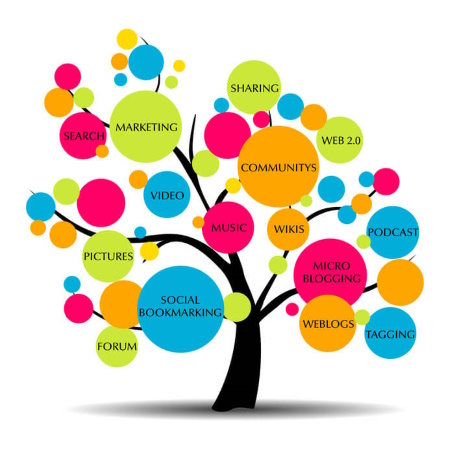
Are there any major differentiators when it comes to inbound vs content marketing, and what are they? Caution. You’ve just unwittingly stepped into one of the fiercest marketing debates today. While both inbound and content marketing are relatively new practices, they’ve both won some serious proponents (and probably a few detractors) during their years in use.
Simply Googling the phrase will bring up search results with strong opinions on both sides. To help you become an informed marketer (or debate participant, your choice,) we’ve curated a comprehensive history of the practices, as well as highlighted the differences and similarities, and some insight on how you can apply these tactics at your business:
History of the Terms
Both inbound and content marketing rose to prominence for the same reason, which was a rapidly shifting landscape of consumer behaviors. While mass email messages occurred as early as the 1970’s, it wasn’t until the mid-1990’s that internet usage at home, on personal computers really began to take off.
Jack Liu reports that in 1994, corporate spending on internet marketing was close to nothing. However, the very next year, it was a whopping $400 million. As consumers began to unlock the wonders of electronic messages, and navigated websites pre-search engines, some of the very sharpest marketing minds (including Gary Vaynerchuk) realized that this internet thing was going to be huge.
They were right, it turns out. Over the past 20 years, the internet has slowly overtaken the way consumers interact with brands. These fast-shifting behavior patterns have rendered many forms of traditional marketing a lot less effective than they used to be. Where there is a consumer there’s a marketer- hence the explosion of inbound and content marketing methodologies.
Inbound Marketing
The absolutely official explanation for “inbound marketing” is that it was coined by HubSpot co-founder Brian Halligan in 2005. Within a year of developing the idea, Halligan and MIT technologist Dharmesh Shah had founded HubSpot, a cloud-based service that aimed to provide everything marketers needed to launch a comprehensive, permission-based marketing strategy.
While this concept has evolved significantly over a decade, at its core, inbound marketing is about attraction – pulling your prospects towards you, instead of pushing your message. A typical inbound marketing strategy may include content creation and distribution, via blogging, social media and email marketing, in order to generate, nurture, and close leads. The basic idea of this approach is outlined in the graphic below:
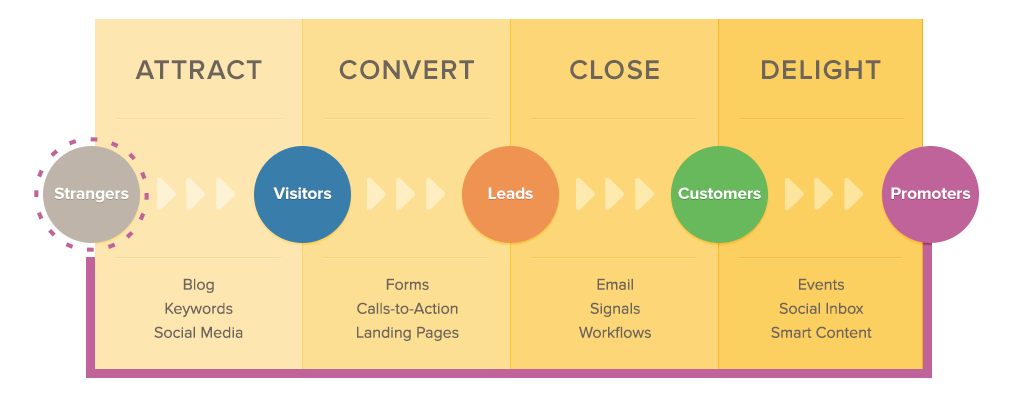
However, agency executive John McTigue traces the origins much further back, to the mid 1850’s. Mechanical Harvester Inventor Cyrus Hall McCormick used educational methods to drum up interest in his farm equipment, as opposed to more traditional paid advertising.
Some of the world’s sharpest brands, including General Electric, began moving towards more equal relationships with their customers around the 1950’s and 60’s, by choosing to integrate their customer feedback into their product development lifecycle.
Content Marketing
Leading subject matter expert Joe Pulizzi believes the idea of content marketing was first put into practice in 1895 by John Deere, one of the world’s first brand publishers. Their magazine “The Furrow” had a circulation of 1.5 million, and an objective to educate their end users on farming best practices:
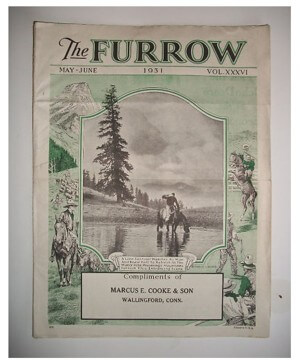
While tractor sales were certainly a nice side effect of John Deere’s unique outreach, it wasn’t an explicit goal. Throughout much of the 20th century, brands began to engage more and more in distributing free content with a stated purpose of providing value to their customers.
Jello published free recipe books, Hasbro sponsored comic books, and Proctor & Gamble sponsored serial radio dramas (which is, in fact, where the term “soap opera” originated). However, for the sake of any purists reading, Pulizzi himself coined the term in around 2001, to describe the increasing phenomenon.
While the practice wasn’t exactly new, brands were dealing with the fact that consumer trust in paid advertising had begun to plummet. You had to earn trust and respect, not push your product, when it came to your marketing messages.
The art of providing value to your audience was a marketing tactic built for the future. We feel the infographic below does a pretty good job of putting the idea into pictures:
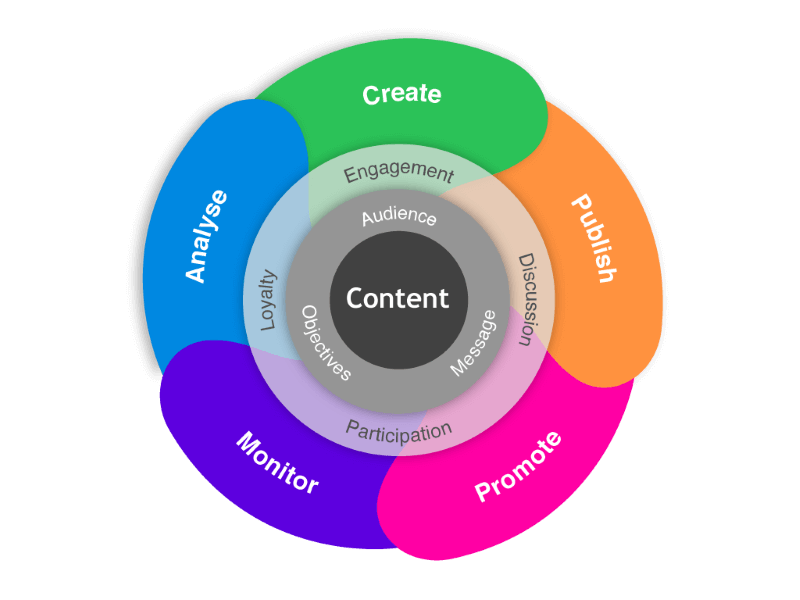
What’s the Main Difference with Inbound vs Content Marketing?
The discussion gets pretty complicated when you get down to dissecting the actual differences of inbound vs content marketing. While the terms are distinct, there’s variation in how they’re used, even by leading professionals.
For the sake of simplicity, I’ve chosen to go with HubSpot and Joe Pulizzi of Content Marketing Institute’s own definitions of the terms: “Inbound marketing focuses on creating quality content that pulls people toward your company and product, where they naturally want to be. By aligning the content you publish with your customer’s interests, you naturally attract inbound traffic that you can then convert, close, and delight over time.” – HubSpot
“Content marketing is a marketing technique of creating and distributing relevant and valuable content to attract, acquire, and engage a clearly defined and understood target audience – with the objective of driving profitable customer action.” – Content Marketing Institute
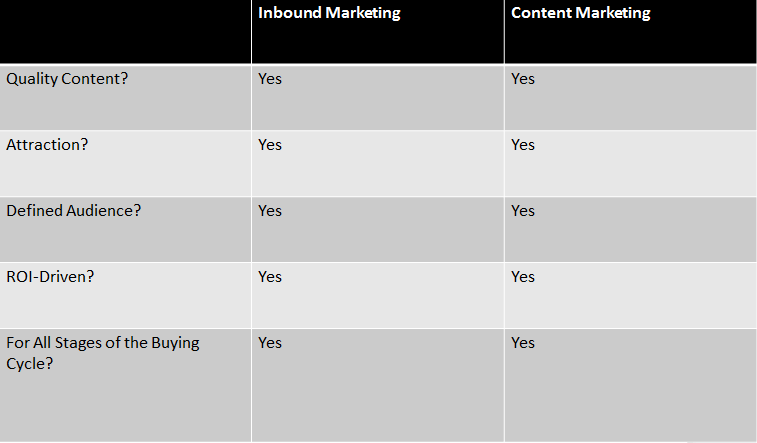
Noticing a bit of a trend here? The definitions are actually pretty similar when you get right down to it. I mean, look how much they actually have in common: In fact, Joe Pulizzi even admitted in a 2010 presentation at HubSpot’s headquarters that the two practices were pretty much exactly the same thing, stating “we are indeed all media companies today and it doesn’t really matter what you call it.” Or does it?
Inbound vs Content Marketing isn’t Actually that Simple
One thing inbound marketing is specifically built to address is the idea of SMarketing – sales/marketing alignment. That’s not to say that content marketing isn’t a practice designed to support the sales process, because it certainly is.
However, a mature inbound marketing program will include lead scoring and lead nurturing, so the sales team is only receiving high-qualified leads. While high-quality content can certainly help in this process, few purist content marketers I’ve encountered address the idea of sales-marketing alignment regularly.
Also, some could argue very easily that content marketing is only one component of an inbound marketing strategy. An advanced inbound marketing program will include data-based customer models, the application of decision science in order to progressively profile leads, and things like marketing experiments for conversion optimization.
While all of these involve content, they’re not really content marketing because they’re analytics-based models for the sole purpose of internal program improvement. Sure, they’re data, and data is information, and information is content.
But when I say “brand publisher,” do you think about A/B testing? Probably not. However, this same argument could be easily flipped on its head. What about a branded magazine that’s sent via snail mail (Content Marketing Institute publishes a fabulous one)? Or high-quality direct mail drop? Or a quality video clip that’s filmed as a television ad? Or developing a transactional relationship with digital influencers, who will in turn promote your product?
All of these ideas are forms of content, and most are highly effective. However, they definitely don’t fit into the inbound model in it’s very purest form.
What Does this Mean for My Company?
Let’s get one thing completely straight. Regardless of whether you choose to go with inbound vs content marketing, a hybrid of the two practices, or a program completely of your own design, you’re going to need to create content. Lots, and lots of quality content.
Content to attract visitors to your website, convert them to leads, and educate them on their purchase decisions. Blogs, eBooks, and whitepapers to improve your SEO, and engagement on your social media channels.Content marketing is at the heart of any effective modern marketing strategy, and we’re absolutely living in an era where it’s crucial that brands are also publishers.
However, every organization has got to make a decision about how they target and distribute this content, aside from the whole inbound vs content marketing debate. Will you publish it to the web, in guest blogs, email newsletters, or social media? Does your content include enough information for your current customers, or existing leads?
All of these questions, and many more, are what actually take your marketing program from theory to effective practice.
So, what’s the consensus on inbound vs content marketing?
Regardless of which side of the fence you fall on in the inbound vs content marketing debate, I think one thing’s pretty clear. The two are very similar indeed.
However, there are a few very distinct differences. In my professional opinion, the worst thing you can do is adopt inbound or content marketing at the total exclusion of the other. If you’re doing inbound, don’t dismiss pay-per-click advertising simply because it doesn’t fit into your model.
Similarly, content marketers shouldn’t try to improve their communication and transparency with the sales department simply because it’s not often discussed in content marketing circles. The only way to determine what’s going to help you exceed your KPIs as a marketer is research, testing, and the ability to pivot quickly. Fail fast, and improve quickly.
Do you think there are any significant differences when it comes to inbound vs content marketing? It’s a pretty hot topic, so share your thoughts in the comments!

Comments (0)